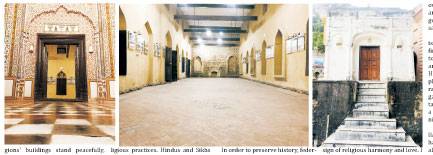ISLAMABAD-From 66 years Ram ki Devi Hindu Temple is silent. No Samriddhi (ritual bell) sound. No Ram and Devi statue. Dharmshala is next to temple. Walls are in worst condition and dim lights are installed inside the Dharmshala hall to make historical pictures visible.
The Sikh gurdwara with yellowish tomb with Hindu temple attracts its surrounding. Gurdwara is empty, even the religious book of Sikh Community Gurugrant is no more here. No worship, no one performing Sukhmani (prayer for peace in Gurdwara). Alongside the temple a big room is attached, which serves as a school for Sikh community where they learn philosophy of Guru Nanak. What makes it different is that temple and Gurdwara are at same place.
A mosque was also there but it is no more. These temples located near Parliament are situated on the slopes of Margalla hills from 300 years. The village Saidpur was established approximately 500 years ago. According to locals, it is Hazrat Shah Wali brainchild. He donated land where three different religions’ buildings stand peacefully, next to each other. Before partition Sikh and Hindus were residing here and frequently visited their temples, performed religious practices and stayed in Ashram.
“I still remember we took our primary classes in Ashram hall. My ancestors belong to Saidpur. We are locals. These temples are vacant since partition.
It changed everything. Sikhs and Hindu went to India. Before 50s, Sikhs, Hindus, and Muslims used to live without segregation and do religious practices. Hindus and Sikhs came from India and Punjab for worship and they stayed at Dharamshala. In 1953, temples and Dharamshala were declared primary school, which later became middle school. Somehow, some Sikhs and Hindus often visit their temples. It has been a long time since the temples are silent no prayers no bhajans. There is no worship or religious activity by Sikhs and Hindu. Sikh and Hindus are no more at Saidpur,” Raja Nasr Ghakkar said who claims to be a descendant of Sultan Said Khan.
In order to preserve history, federal government initiated to renovate temples and Dharamshala in 2005. 97 historical pictures of federal capital of Pakistan are on Dharamshala wall. Tourist considers it a museum. Inauguration stone also witnessed that it is 300 years old. Still Hindi poetry and verses are engraved on floor.
“I was taking tea and observed yellow tombs. I left my cup on table and went towards tombs. It boggles the mind when I see Hindu Mandir and Sikh Gurdwara under one roof it is a sign of religious harmony and love. I have visited many countries. The diversity and love in Pakistan is unforgettable. Pakistan is much safe for tourists. The edifice temple doors, stairs, walls are inescapable and show attractive traditional art and calligraphy,” Tom, a travel blogger from Holland said.
A tourist from Lahore Aroohi Bilal stated that we hear about the village on social media. “It is my first visit to temples and Dharmshala. It is unique and shows freedom for all regardless race and religion, moreover Pakistan for all. Architecture and gallery are amazing. I love how government preserved temples,” she said.
Ellie Quinn from England a tourist and travel Blogger said, “It is my first visit to Pakistan. I am surprised to see intriguing historical temples and art. These temples show that Hindus, Sikh and Muslims lived and played together without hate. Decorated walls and doors are attractive, gallery represents history and shows talent in Pakistan. Village looks like a jewel in the shell in peaceful evenings of Islamabad.”
The supervisor of temples Nasurllah Kiyani sitting at the Sikh study hall with a table and traditional wooden chairs stated that security guards are here all the time and we have staff of four sweepers. Foreigners have deep interest in temples as well as Saidpur. Usually students of history and religion studies visited our office for research and project.
In the light of dim wall lamp, he further added that somehow Sikh and Hindus also visited temples specially those who belongs to Saidpur and now in settled in India and abroad they still love us and our land.
–The writer is a freelance contributor
Tuesday, April 16, 2024
The silent temples

IHC dismisses Bushra Bibi's plea seeking her shifting to Adiala Jail from Bani Gala
4:25 PM | April 16, 2024
Punjab CM visits Tehsil Headquarter Hospital Murree
3:25 PM | April 16, 2024
High-level Saudi delegation in Islamabad to hold meetings with Pakistani leadership
2:07 PM | April 16, 2024
Saudi foreign minister meets PM Shehbaz Sharif
1:17 PM | April 16, 2024
Decision to retaliate against Iran attacks rests with Israel, says Pentagon
1:05 PM | April 16, 2024
Political Reconciliation
April 16, 2024
Pricing Pressures
April 16, 2024
Western Hypocrisy
April 16, 2024
Policing Reforms
April 15, 2024
Storm Safety
April 15, 2024
Democratic harmony
April 16, 2024
Digital dilemma
April 16, 2024
Classroom crisis
April 16, 2024
Bridging gaps
April 16, 2024
Suicide awareness
April 15, 2024
ePaper - Nawaiwaqt
Advertisement
Nawaiwaqt Group | Copyright © 2024





